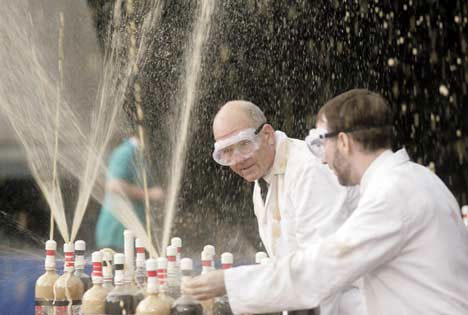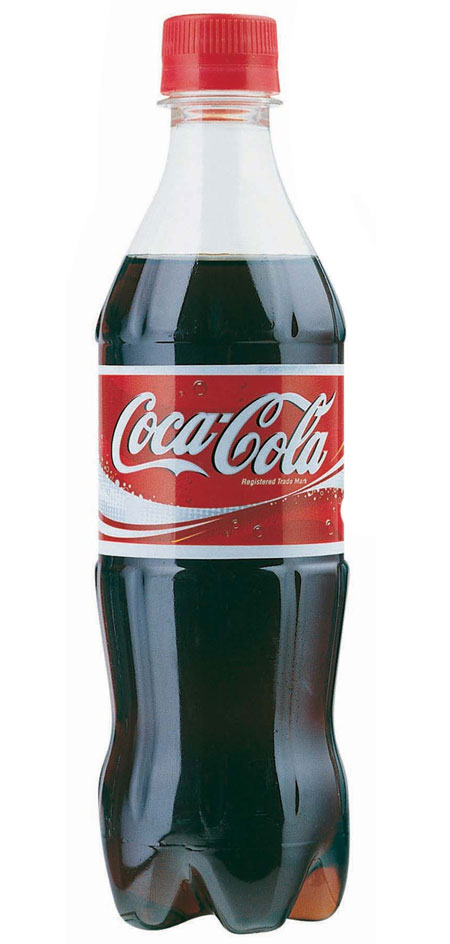Explain why not eat Mentos candy with Coca cola
Eating mentos candy combined with cocacola can be deadly.
Did you ever drink C effervescent by straightening C tablets into your mouth and drinking water? In fact, it's okay. But it would be foolish, if I put some mentos candy into my mouth and drink another can of cola. At that time, you can imagine, in your mouth, there will be a reaction as shown below:

Why?
If you're a specialty, you've probably tried making carbonated lemonade. It's quite simple, just put some NaHCO 3 powder in a cup of lemonade to make it yourself, then the foam and gas will rise, when drinking makes a strange feeling. The essence is just the reaction between NaHCO 3 and some organic acids in lemon juice. Reaction equation:
NaHCO 3 + H + ========== Na + + CO 2 + H 2 O.
NaHCO 3 is not toxic to the body, it is even a treatment for gastritis, if pure. Of course, if you don't have pure preparations, don't try to drink, just try to see it. Perhaps you are thinking that the mechanism here is similar to that of carbonated lemonade?
Wrong!
To understand this reaction mechanism, try examining the chemical composition as well as the physical properties of the two components: Cocaine and Mentos. About chemical composition:
Ingredients Cocacola
Water, CO2, caramel coloring agent, flavoring agent: vanilla, cinnamon, citrus, sweetener: sugar, syrup or artificial sweetener, preservative. Cocacola has an acid environment.

MentosC component
Flavors: mint, orange, strawberry, lemon, apple, grape .; sugar, starch, emulsifiers, gum arabic, hydrogenated coconut oil, gelatin.

As for physics, studying the process of creating these two components, we can look at some remarkable points:
In Cocolaola: As we know, the solubility of gas in water is directly proportional to pressure and inversely proportional to temperature . The nature of creating the gas of any carbonated soft drink is to use high pressure, compress the CO2 gas to the point that it is saturated with the fresh water. When we open the bottle, the pressure in the bottle is much larger than the atmospheric pressure, and the solubility of CO 2 abruptly decreases, carbon dioxide is released and creates carbon bubbles. Before opening, if you jug the soft drink, the solubility of the gas has begun to decrease, a part of the gas that no longer dissolves onto the empty space in the bottle increases the pressure in the bottle, and increases the pressure difference when you open, so the foam will come out very strong. Also note that CO 2 , if you drink it in the stomach, it will be fine, or at the same time, is bloating, otherwise it will be discharged by mouth (belching), or anus (sniffing).
Thus, in carbonated soft drinks will maintain dynamic balance:
HCO 3 - <==> H 2 CO 3 <==> CO 2 + H 2 O
If the HCO 3 component is increased or supplemented, the chemical equilibrium will shift to the right and CO 2 is released. The problem is, to ensure safety, the manufacturer adjusts its composition so that CO 2 is released slowly during the drinking process.
Dissolved CO 2 causes soft drinks to have a low pH or in other words, high acidity. On the other hand, the use of preservative 338 in Coca Cola soft drinks that the manufacturer listed on the label, also contributed to reducing the pH of Coca Cola. 'Because the preservative 338 is phosphoric acid, it maintains pH stability'.
Scientists initially checked that the Coca Cola's pH was 3 (pH 3).'That's too low'!
Regarding mentos, the structure of mentos also has CO 2 components in the form of ions, furthermore, these components are encased outside by a layer of sugar. There are also many types of mentos candies, however, not all Mentos peppermint candies cause such reactions. In the first step, scientists found that mentos only marshmallows (Chewy Gragees) are dangerous. The squares and pupae have not seen that phenomenon yet. This is explained by the fact that in the form of a circle, the layers of sugar are pressed on the surface of the candy, not completely covered, but microscopic, they have thousands of cracks on the surface.
And finally, some hypotheses are given:
Explain in detail why not eat Mentos candy and drink Cocacola?
The nature of the mentos tablet component is not ionized CO 2 or when added to coca, there is a reaction of HCO 3 (-), which causes dynamic equilibrium shift: HCO 3 - <==> H 2 CO 3 <== > CO2 + H2O, creating a large amount of CO 2 .

Surface and movement mechanism of mentos : The nature of water molecules is hydrogen bonding. This link affects the solubility of CO 2 in water. Anything that disrupts this link reduces the solubility of CO 2 in the solution. When the mentos enter the water, the heavy mentos sink (moving from the top down), furthermore the surface is very cracked, disrupting hydrogen bonding, reducing the solubility of CO 2 .
There is no or no possibility of an acid-base chemical reaction such as a carbonated lemonade cup at the beginning of the article, because an experiment shows that before and after the experiment has not changed.
Not just eating mentos candy and drinking coca cola is deadly dangerous. It depends on the type of candy and the amount of reactants. If proper candy and candy are large enough to be dangerous, and in fact, a few fatalities have occurred.
Around this topic, there are many problems that have not been explained properly. If it is an ordinary person, it is clear that the round pill mentos reduces the solubility of CO 2, so when it comes to Coca Cola, this phenomenon will occur. As for scientists, the problem of cracking on candies and the reason that not all cause this reaction is still a question that many people ask unsolved questions.
- 10 useful uses of cola may not know
- Ship Coca Cola bottle made of ice
- Coca-cola has just been launched in Japan, with fewer calories and more caffeine
- March 12: The first Coca-Cola bottle was produced and sold in the US
- What did a can of Coca Cola do with your body for 1 hour?
- Apple and Coca Cola offer free iTunes music -
- The secret to better drinking Coca Cola is that you don't notice it
- Put salt into Coca and the unexpected ending
- Lenovo introduced a new laptop model
- Do you know what part of the Tic Tac candy box lid is used?
- Explain why peppermint candy makes us
- The most of the village sharing YouTube videos
 Green tea cleans teeth better than mouthwash?
Green tea cleans teeth better than mouthwash? Death kiss: This is why you should not let anyone kiss your baby's lips
Death kiss: This is why you should not let anyone kiss your baby's lips What is salmonellosis?
What is salmonellosis? Caution should be exercised when using aloe vera through eating and drinking
Caution should be exercised when using aloe vera through eating and drinking Obesity is inherited from father to child, he goes to grandchildren
Obesity is inherited from father to child, he goes to grandchildren  First round, weight and IQ in children
First round, weight and IQ in children  For the first time there was a banquet with artificial meat
For the first time there was a banquet with artificial meat  Bone marrow transplant to treat AIDS
Bone marrow transplant to treat AIDS  Will future people have mines instead of teeth?
Will future people have mines instead of teeth?  MERS-CoV virus can hardly become a pandemic
MERS-CoV virus can hardly become a pandemic 